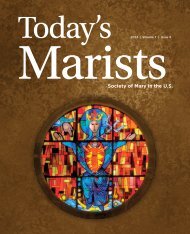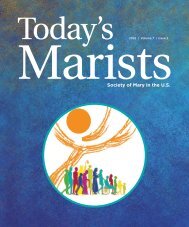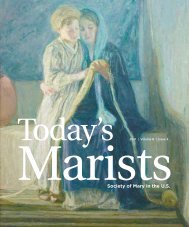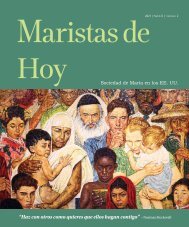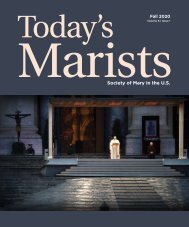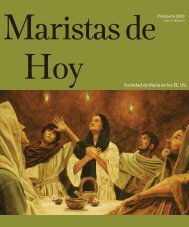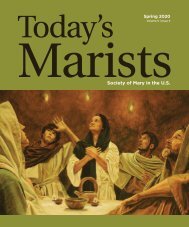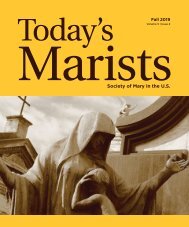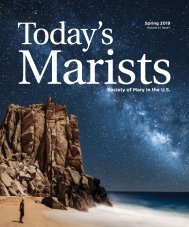Today's Marists 2024 Volume 8, Issue 2
Create successful ePaper yourself
Turn your PDF publications into a flip-book with our unique Google optimized e-Paper software.
to the periphery.” At the same time,<br />
Nelson contends that the film makes<br />
“a strong statement that it’s no longer<br />
acceptable to extract valuable assets<br />
from Indigenous communities –<br />
whether that be our stories or our<br />
natural resources – without our<br />
consent and input.”<br />
For white, American Catholics, Killers<br />
of the Flower Moon’s importance<br />
lies in its ability to stir our collective<br />
conscience. As Pope Francis reminds<br />
us: “We can never move forward<br />
without remembering the past; we do<br />
not progress without an honest and<br />
unclouded memory” (Fratelli Tutti,<br />
249). In this light, films like Killers<br />
of the Flower Moon “keep alive the<br />
flame of collective conscience” by<br />
reminding us of the depravity that we<br />
exhibit at our worst and inviting us<br />
to restore wrongs perpetrated in our<br />
past. A prayerful encounter with the film allows us to be wounded<br />
by the atrocities of history and stirred into active solidarity.<br />
Model of an Ally:<br />
Betty Peace-Gladstone<br />
As important as it is to be touched by the violence of history, it<br />
is equally important to remember those who “amid such great<br />
inhumanity and corruption, retained their dignity and, with<br />
gestures small or large, chose the part of solidarity, forgiveness, and<br />
fraternity.” (Fratelli Tutti, 249) Lily Gladstone’s mother, Betty Peace-<br />
Gladstone, who stands among those examples of solidarity, testifies<br />
to the presence of grace working amidst violence and inhumanity.<br />
For Betty Peace-Gladstone, a white woman and (now retired)<br />
professor of early childhood education, mothering an Indigenous<br />
child convinced her that Native children needed to be connected<br />
to their native language. As Peace-Gladstone told National Public<br />
Radio, Indigenous languages carry a “reflection of the people’s<br />
relationship to the land, the creatures, the elements that exist in the<br />
land and kinship terms … as people study their own language …<br />
those elements of culture become a lot more apparent to them and<br />
a lot more dear.”<br />
This experience pushed Peace-Gladstone to advocate for Blackfeet<br />
language instruction in schools. While there were several members<br />
of the community willing to serve as teachers, Peace-Gladstone<br />
notes that there were institutional barriers: finding funding to pay<br />
Indigenous teachers and overcoming certification requirements.<br />
As a result of Peace-Gladstone’s partnership with the Blackfeet<br />
community, the Blackfeet language is being taught more frequently<br />
in schools.<br />
Colinian Eschatology and<br />
Indigenous Solidarity<br />
Fr. Jean-Claude Colin, the founder of the Society of Mary, believed<br />
that “the Society of Mary must re-create the early days of the<br />
Church” (A Founder Speaks, #115, 5) by being a community<br />
of cor unum et anima una – of one heart and soul. There is an<br />
assimilationist temptation within this<br />
eschatological vision: we become<br />
Marist by all learning to think, feel,<br />
judge and act in the same way. The<br />
problem with this temptation is<br />
twofold: first, it denies the uniqueness<br />
of gifts given to individuals and their<br />
own particular communities; second,<br />
considering how frequently power is<br />
abused, ‘subsuming’ particularities<br />
under some larger universal should<br />
rightly strike us as indicative of a<br />
colonialist mindset capable of great<br />
violence.<br />
I propose that we understand Fr.<br />
Colin’s eschatology as gesturing<br />
towards a kind of solidarity rooted<br />
in the heart of a mother. Re-creating<br />
those days of cor unum et anima<br />
una does not involve subsuming<br />
differences, but rather expanding<br />
consciousness so that all people –<br />
especially those most on the margins of Church and society – can<br />
experience the heart and soul of the Church in creative solidarity.<br />
Given the continued obstacles to justice that Native American<br />
communities face in the United States, I believe that white, American<br />
Catholics can express this solidarity in four ways:<br />
1. Education: White, American Catholics need to learn more<br />
about Indigenous history, culture, and language. Start by<br />
learning on whose ancestral home you live and work (this<br />
interactive map, native-land.ca, is a good place to start).<br />
2. Encounter: Use this information to encounter local Indigenous<br />
communities, networks and advocacy organizations. Build<br />
relationships and ask how you can offer support. Encounter<br />
may also entail encountering stories, art, culture and language<br />
of Indigenous peoples.<br />
3. Acknowledge: Consider building a land acknowledgement<br />
into liturgies, prayers of intercession or meetings. Such an<br />
acknowledgement allows your community to situate itself<br />
within the history and context of the land and its people<br />
(view this resource, bit.ly/4a9W1sp, as a guide to land<br />
acknowledgments).<br />
4. Advocate: The United States government recognizes 574 distinct<br />
Native American tribes. These tribes face unique challenges<br />
and situations. Nevertheless, Indigenous rights organizations<br />
highlight some common obstacles to justice that Native<br />
communities face today: epidemics of violence, environmental<br />
degradation and unequal justice before the law. Learn about<br />
the needs in your local community or investigate resources<br />
for advocacy from organizations like the Indian Law Resource<br />
Center (indianlaw.org).<br />
By expressing solidarity with Indigenous communities in these<br />
ways, I believe that white, American Catholics can help bring Fr.<br />
Colin’s eschatological vision a little closer to reality within our own<br />
context.<br />
<strong>Volume</strong> 8 | <strong>Issue</strong> 2 13




